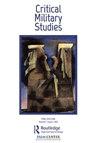‘Can I Be Gay in the Army?’: British Army recruitment advertising to LGBTQ youth in 2017–18 and belonging in the queer military home
Q1 Arts and Humanities
引用次数: 0
Abstract
ABSTRACT In 2017, the British Army opened its ‘This is Belonging’ recruitment campaign, aimed at groups of young people who were considered traditionally less likely to join the Army, with marketing at Pride in London aimed at LGBTQ youth. The campaign’s next phase, in 2018, consisted of live-action and animated YouTube videos targeting specific groups including young women, religiously observant youth, emotionally sensitive young men, youth with average fitness levels, and, in the animations, LGBTQ youth again. While every other theme appeared in both sets of videos, the live-action set contained a video depicting homosocial male bonding instead of any LGBTQ theme. The Army’s acknowledgement of LGBTQ identities during recruitment in 2017–18 suggested certain advances from the 2000s position where LGBTQ personnel were expected to keep their sexuality private. A close audiovisual analysis of the LGBTQ-themed video, ‘Can I be Gay in the Army?’, and its intertextual relationship with the other videos nevertheless reveals hesitancy over how to represent a legibly gay male soldier that hints at limits to the institution’s inclusion of sexual difference. Drawing on both ‘LGBT’ and ‘Queer’ scholarship, the paper illustrates how concepts of domesticity and futurity can contribute to critical understandings of LGBTQ military inclusion.“在军队里我能成为同性恋吗?”: 2017-18年英国陆军招募LGBTQ青年的广告,属于酷儿军事之家
2017年,英国陆军开展了“这就是归属感”(This is Belonging)征兵活动,目标人群是传统上被认为不太可能参军的年轻人,而Pride In London的营销目标人群则是LGBTQ青年。该活动的下一阶段将于2018年开始,包括针对特定群体的真人和动画视频,包括年轻女性、宗教虔诚的年轻人、情感敏感的年轻人、健康水平平均的年轻人,以及在动画中再次出现的LGBTQ年轻人。虽然两组视频中都出现了其他主题,但真人版的视频中却没有任何LGBTQ主题,而是一个描述同性恋社会男性关系的视频。陆军在2017-18年的征兵过程中承认LGBTQ身份,这表明,与2000年代相比,LGBTQ人员被要求对自己的性取向保密,这在一定程度上取得了进步。对以lgbtq为主题的视频《我能在军队里是同性恋吗?》,然而,它与其他视频的互文关系揭示了如何表现一个明显的同性恋男士兵的犹豫,这暗示了该机构对性别差异的包容的局限性。本文借鉴了“LGBT”和“酷儿”两方面的学术研究,阐述了家庭生活和未来的概念如何有助于对LGBTQ军人包容的批判性理解。
本文章由计算机程序翻译,如有差异,请以英文原文为准。
求助全文
约1分钟内获得全文
求助全文
来源期刊

Critical Military Studies
Arts and Humanities-History
CiteScore
1.90
自引率
0.00%
发文量
20
期刊介绍:
Critical Military Studies provides a rigorous, innovative platform for interdisciplinary debate on the operation of military power. It encourages the interrogation and destabilization of often taken-for-granted categories related to the military, militarism and militarization. It especially welcomes original thinking on contradictions and tensions central to the ways in which military institutions and military power work, how such tensions are reproduced within different societies and geopolitical arenas, and within and beyond academic discourse. Contributions on experiences of militarization among groups and individuals, and in hitherto underexplored, perhaps even seemingly ‘non-military’ settings are also encouraged. All submitted manuscripts are subject to initial appraisal by the Editor, and, if found suitable for further consideration, to double-blind peer review by independent, anonymous expert referees. The Journal also includes a non-peer reviewed section, Encounters, showcasing multidisciplinary forms of critique such as film and photography, and engaging with policy debates and activism.
 求助内容:
求助内容: 应助结果提醒方式:
应助结果提醒方式:


